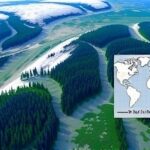In a surprising twist for environmental science, satellite imagery from across the globe shows Forests encroaching higher up mountain peaks, pushing the tree line upward at rates that defy simple explanations tied to global warming. Researchers analyzing decades of data argue that this migration of tree lines may stem from overlooked ecological dynamics rather than solely climate change, prompting a reevaluation of how we understand forest adaptation in rugged terrains.
This phenomenon, observed in mountain ranges from the Alps to the Rockies, indicates that trees are colonizing elevations once deemed too harsh for growth. While warmer temperatures were long blamed, new studies suggest factors like reduced grazing by wildlife and land-use changes could be the real drivers, offering a more nuanced view of ecology in action.
Satellite Data Exposes Rapid Tree Line Advances Worldwide
High-resolution satellite imagery, captured by NASA’s Landsat program and the European Space Agency’s Sentinel satellites, has painted a vivid picture of shifting landscapes. Over the past 30 years, tree lines in various mountain ecosystems have migrated upward by an average of 20 to 30 meters per decade in some regions, according to a study published in the journal Ecological Applications. This upward creep is most pronounced in temperate and boreal Forests, where coniferous and deciduous species are venturing into alpine meadows previously dominated by shrubs and grasses.
In the Swiss Alps, for instance, researchers from the University of Zurich documented a 15% expansion of forested areas above 2,000 meters since the 1980s. Similar patterns emerge in the Cascade Range of the Pacific Northwest, where Douglas fir and other species have gained footholds at elevations up to 100 meters higher than historical norms. “The clarity of these images is staggering,” said Dr. Elena Vasquez, lead author of the study. “We can literally see the green frontier advancing, pixel by pixel, challenging our preconceptions about static ecosystems.”
These observations aren’t isolated. In the Andes of South America, satellite data reveals tree line shifts in cloud Forests, where native species like the Polylepis are reclaiming slopes affected by historical deforestation. Ecologists attribute part of this to reforestation efforts, but the pace suggests deeper ecological interactions at play. Statistics from the Global Forest Watch initiative corroborate this, showing a net gain of 5.2 million hectares in high-elevation forests globally between 2000 and 2020, much of it along mountain peaks.
Yet, this migration isn’t uniform. In arid regions like the Sierra Nevada, advances are slower, hinting at regional variations influenced by soil moisture and precipitation patterns. By integrating ground-based surveys with remote sensing, scientists have mapped these changes with unprecedented accuracy, fueling debates on the drivers behind such dynamic forest behavior.
Decoupling Tree Line Shifts from Climate Change Assumptions
For years, the prevailing narrative linked rising tree lines directly to climate change, positing that milder winters and longer growing seasons enable trees to thrive at higher altitudes. However, a consortium of ecologists from institutions including the USDA Forest Service and the Max Planck Institute for Biogeochemistry now challenges this view. Their analysis, drawing on climate models and ecological surveys, indicates that while warming contributes marginally, it’s not the primary force.
“We’ve modeled temperature increases, and they account for only about 20-30% of the observed shifts,” explained Dr. Markus Lehmann, a senior researcher involved. “The rest points to human and biotic influences that we’ve underestimated.” In essence, climate change may be a facilitator, but not the sole architect of these forest migrations up mountain peaks.
One key revelation comes from historical data comparisons. In areas with stable temperatures, like parts of the Japanese Alps, tree lines have still advanced due to decreased herbivore pressure. Populations of deer and goats, once culled or displaced by human activity, have rebounded in some spots, but in others, protective fencing and reduced livestock grazing have allowed saplings to survive. A meta-analysis in Nature Ecology & Evolution reviewed 150 studies and found that land abandonment—where farming ceases on steep slopes—correlates strongly with upward forest expansion, independent of temperature rises.
Moreover, nutrient cycling in soils plays a role. As atmospheric nitrogen deposition from pollution increases, it fertilizes higher elevations, boosting tree growth. This anthropogenic boost, unintended as it may be, mimics natural ecological processes but accelerates them. Quotes from field biologists underscore the surprise: “I expected heat to be the villain, but it’s more like a supporting actor,” noted Prof. Aisha Patel from the University of Colorado, who has trekked these changing slopes for two decades.
These findings ripple through climate policy discussions. If tree line migrations aren’t purely climate-driven, then projections for carbon sequestration in forests—vital for mitigating global warming—may need recalibration. Ecologists warn that over-attributing changes to climate change could blind us to actionable interventions, like managing grazing to preserve biodiversity hotspots.
Ecological Drivers Reshaping Mountain Forest Dynamics
Beyond temperature, a web of ecological factors is propelling forests toward mountain peaks. Seed dispersal, a cornerstone of forest ecology, has intensified in some areas thanks to birds and wind patterns altered by landscape changes. For example, in the Appalachian Mountains, avian vectors carry seeds upslope more efficiently as lower forests mature and produce abundant fruit.
Competition among species also factors in. As shrubs retreat due to drought or overgrazing recovery, trees face less rivalry for sunlight and water. In the Pyrenees, studies show that pine species have outcompeted junipers at mid-elevations, leading to a cascading effect where the tree line inches higher. “Ecology isn’t linear; it’s a symphony of interactions,” says Dr. Liam Chen, an ecologist at the Smithsonian Environmental Research Center. His team’s experiments, planting seedlings at varying altitudes, reveal survival rates 40% higher in grazed-exclusion zones compared to open areas.
Soil microbiology adds another layer. Mycorrhizal fungi, symbiotic partners to tree roots, are extending their networks upward, aiding nutrient uptake in nutrient-poor alpine soils. Satellite imagery paired with soil core samples from the Tibetan Plateau demonstrates how these underground alliances enable birch and spruce to colonize barren zones. Yet, this isn’t all positive; invasive species hitchhiking on these migrations threaten native ecology, potentially disrupting fragile mountain biodiversity.
Human footprints are indelible too. Reforestation projects in Europe, such as the EU’s LIFE program, have deliberately planted species at higher elevations to combat erosion, contributing to observed shifts. In contrast, wildfires—intensified by climate change—can reset tree lines downward temporarily, as seen in Australia’s Snowy Mountains after the 2020 bushfires. Balancing these elements requires integrated approaches, blending remote sensing with on-the-ground ecology to forecast future forest trajectories.
Statistics highlight the scale: The International Union for Conservation of Nature reports that 25% of global mountain ecosystems show altered tree lines, with implications for water cycles as forests influence snowfall and runoff. This underscores the interconnectedness of ecology, where mountain peaks serve as barometers for broader environmental health.
Implications for Biodiversity and Conservation Strategies
As tree lines climb mountain peaks, the ripple effects on biodiversity are profound. Alpine species, adapted to cold, treeless expanses, face habitat compression, potentially leading to extinctions. In the Rockies, pikas and marmots are retreating higher, only to find their refuges shrinking as forests advance. Conservationists advocate for protected corridors to allow species movement, emphasizing that understanding non-climatic drivers can inform targeted protections.
Carbon dynamics shift too. Higher-elevation forests store more carbon per hectare due to slower decomposition, but if migrations are fueled by land-use changes, sustainability hinges on policy. The UN’s Decade on Ecosystem Restoration calls for monitoring these shifts to enhance forest resilience against true climate threats like extreme weather.
Looking ahead, interdisciplinary research is key. Upcoming missions, like NASA’s Surface Water and Ocean Topography satellite, will refine our view of hydrological influences on tree lines. Ecologists propose long-term observatories in key ranges to disentangle factors, ensuring that ecology informs adaptive management. “This isn’t just about trees; it’s about reimagining how we steward our planet’s wild places,” Dr. Vasquez concludes.
With forests evolving in unexpected ways, the focus turns to proactive steps: restoring degraded slopes, controlling invasives, and integrating satellite insights into global ecology models. These efforts could safeguard mountain ecosystems, turning potential crises into opportunities for harmonious human-nature coexistence.









